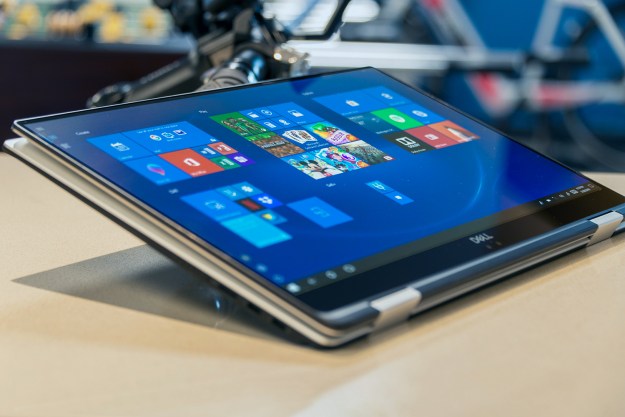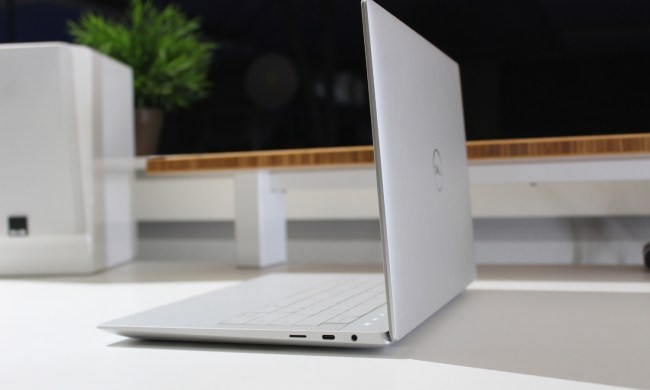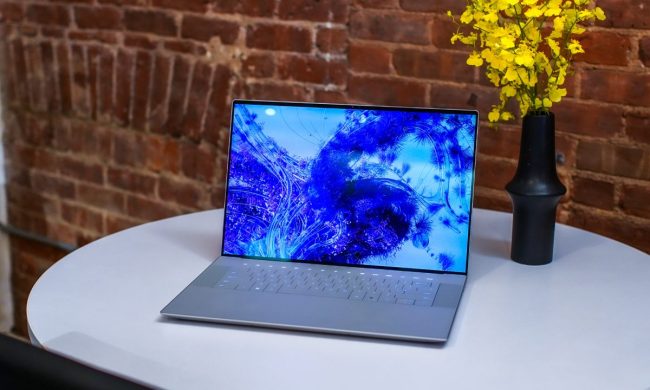
- G-series chip provides great gaming performance
- Exceptional build quality and design
- One of the best laptop displays you can buy
- Quick storage and processing
- Good value for the hardware
- New keyboard is just okay
- Lackluster battery life in 4K model
- Runs loud and hot
The XPS 15 2-in-1 looks like any other laptop in the XPS family. In fact, you may not be able to tell it apart from its older brother, the XPS 15. Outside of the new hinge, it has all the hallmarks of the XPS laptops we’ve come to know and love. Yet you’ll need just a few minutes with the 15 2-in-1 to realize it’s something different.
From its low-travel, magnetic keyboard, to its new Intel Core processor paired with AMD Radeon Vega graphics, Dell has taken risks across the board. While there’s a couple of divisive features about on laptop, for the most part, it’s an experiment gone right.
Taking names and taking chances
In many ways, the XPS 15 2-in-1 is the most experimental of Dell’s XPS
The keyboard, however, is an area the XPS team was determined to make a change — and not everyone will like the results. Taking cues from what Apple did with the MacBook Pro, the XPS 15 2-in-1’s keyboard has extremely short key travel at just 0.7mm. To counteract the feeling of typing against a flat surface, Dell has engineered a magnetic system that tries to add feedback. It does help with tactile feel, but it also takes some time to feel comfortable using.
We eventually found ourselves adjusting to the abrupt bottoming action,
In many ways, the XPS 15
2-in-1 is the most experimental of Dell’s
XPS
It’d be easier to excuse if the XPS 15 2-in-1 was drastically thinner or lighter than other
Another place Dell has made changes is in port selection. The XPS 15 2-in-1 sticks to USB-C and an SD card slot. With four ports, there’s plenty of USB-C to go around, but professionals and gamers who rely on legacy accessories will miss having USB-A. The HP Spectre x360 15 or the Surface Book 2 15 are better options if USB-A is a must-have for you.
The webcam on the XPS 15 2-in-1 is right where you’d expect it — in a terrible spot. It’s still situated under the display, where its unflattering angle depicts you as the double-chinned, fat-fingered monster you were always afraid you’d become. It’s not a highlight for the device, but unless you routinely rely on it for professional conference calls, it’s not a huge concern. Your spouse or friend probably won’t mind you repositioning the screen a bit during calls.
One of the best displays we’ve ever tested
Dell offers two options for displays on the XPS 15 2-in-1: 1080p or

This is hands down one of the most beautiful displays we’ve ever reviewed, even compared to stellar performers like the Surface Book 2 or MacBook Pro. In daily usage the large screen stays bright and colorful, making it ideal for watching videos and playing games.
The story’s no different in our objective tests. Across the board, the
Color accuracy is the only place the display slips, but only just. Though it shows an impressive near-100 percent on both the sRGB and AdobeRGB color scales, it’s color accuracy is a bit behind the competition, with an average color error of 2.73. That’s not terrible, but professional photo and video editors might be better off with the original XPS 15 or the Surface Book 2. Apples MacBook Pro, which returned an incredible average error below one, remains the king of accurate colors.
This is hands-down one of the most beautiful displays we’ve ever reviewed, even compared to Surface Book 2 or MacBook Pro.
The
The second problem is the significant impact on battery life, as we’ll explain in a moment.
As is the case with most
As fast as it is thin
The 8th-gen Core i7-8705G at the heart of the XPS 15 2-in-1 is an impressive piece of hardware. Its Geekbench 4 single-core score of 4,967 surpasses the U-Series chips found in similar 2-in-1s and clamshells, even in Dell’s own lineup. The XPS team did a lot of work to redesign the thermal system, using a combination of Gore materials and larger, more efficient fans. Outside of the ThinkPad X1 Yoga, the XPS 15 2-in-1 is the best performer in single-core tests we’ve ever reviewed. That’s impressive.
The Geekbench 4 multi-core score came in at 14,242, which sits barely behind Dell’s own XPS 13, as well as the ThinkPad X1 Yoga. That’s a bit disappointing. Still, this new processor competes with or beats Core i7 U-Series processors across the board, and that puts it among the fastest mobile CPUs ever made.
Where the CPU shines is in more difficult tasks. We encoded a
Unfortunately, the cooling system is loud. And despite the Gore used, the laptop does become a bit too warm right beneath the keyboard.

Hard drive performance is also top-notch, using an NVMe PCIe SSD from Toshiba that’s blazing fast at both writing and reading. You’ll never have an issue saving and pulling up files from your drive, which is what you want in your SSD. The XPS 15 2-in-1’s speeds sit with
G-series stands for gaming
Ever since the partnership between Intel and AMD was announced, we’ve been eager to benchmark the G-Series chip and hold Intel’s claims of gaming goodness to the fire. The Core i7-8705G comes with AMD’s Radeon RX Vega M GL graphics on board, and this is the first laptop to use it. The results? So far, so good.
The XPS 15 2-in-1 handled 3DMark Fire Strike well, scoring 6,150. That’s strong compared to other entry-level solutions, such as Intel UHD graphics, Nvidia’s MX150, or AMD’s APUs. Some of those options might be cheaper, such as the Asus ZenBook Flip 14, but you’ll see well over twice the graphics performance with the Vega M GL.
Even compared to the GTX 1050 on the XPS 15, the Vega graphics wins out by more than a slim margin. The Surface Book 2’s GTX 1060 is a better performer in 3DMark, and the ZenBook Pro’s GTX 1050 Ti also achieves a small victory
The XPS 15 2-in-1 delivers on the promise of gaming-capable performance in a sleek chassis.
Things look good in games, too. In more entry-level fair, we found that the XPS 15 2-in-1 can easily handle maximum graphics settings at respectable framerates. In Rocket League, it could spit out 60 FPS at High Quality in 1440p. Even in full
While it’s most capable in esports-ready games, the XPS 15 2-in-1 handles more graphic-intensive games, too. We tried out Battlefield 1, and though we didn’t find it playable in
The same goes for a game like Civilization VI — stay away from

Because the graphics component is the same regardless of which configuration you buy, you’ll see the most gaming value out of the $1,300 1080p model. But regardless of which you choose, the XPS 15 2-in-1 delivers on the promise of gaming-capable performance in a sleek chassis. Just remember: RAM is soldered on, so you’re stuck with what you choose.
Battery life is the Achilles heel of 4K
It might not be fair to say this, because we’ve only been able to test the
The same is true our more intensive web browser benchmarks, where it manages nearly half the battery life of many of its competitors — a significant step back from competitors. That’s what a 15-inch,
Our Take
The Dell XPS 15 2-in-1 is an experiment gone right. It’s a beautiful laptop to hold and use, and its gaming performance is a breath of fresh air. The mediocre battery life and experimental keyboard will be sticking points for some, but the trade-off for what you gain in the display, design, and performance make it well worth the purchase for its intended audience.
Are there other alternatives?
The most competitive alternative comes from Dell itself. The original XPS 15 is a more conventional approach to this laptop, both in terms of components and the keyboard. If gaming performance for less is what you care about, the newly refreshed XPS 15 starts at $1,300, which comes with the GTX 1050. You won’t see quite as good of framerates, though you’ll probably be happier about the battery life and keyboard.
The other worthy option is the Surface Book 2, although it’s difficult to compare the pricing apples-for-apples. You gain much better battery life and even better gaming performance on it, but you’ll pay 400 or 500 hundred dollars more, depending on the configuration.
Lastly, if you’re willing to wait until it comes out, the HP Spectre x360 15 features the same G-Series CPU/GPU, that should boast some similar performance. It’ll be a bit heavier and thicker, but it’ll also have a larger battery inside.
How long will it last?
Dell offers a 1-year warranty for its
Should you buy it?
Yes. There are better, more affordable options if you don’t care about playing games. But for a lightweight, affordable laptop that can also pump out decent framerates, it’s one of the very best.







